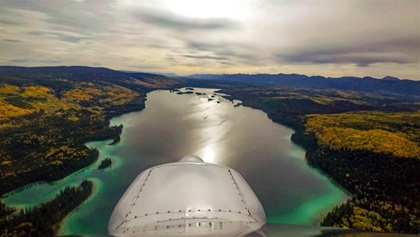Long-range VFR adventures
12 tips for cross-countries that cross the country

When they find out about my cross-country flights in mostly low-and-slow VFR airplanes, they genuinely feel sorry for me. No autopilot, pressurization system, groundspeeds that barely crack 100 knots (if they reach triple digits at all), mountains, turbulence, and multiple time zones to cross.
“That sounds awful,” a corporate jet pilot once told me. “I’d insist on hazardous duty pay for trips like that.”
Yeah, I nod. Keep on thinking that.
Because the truth is, flying under visual flight rules—especially multi-leg, multi-day, transcontinental journeys—is a heck of a lot more challenging, interesting, and rewarding than going IFR and sipping coffee in the flight levels on an instrument flight plan.
I’ve crossed the United States in an AirCam, Piper PA–18 Super Cub, Aviat Husky, Icon A5, Van’s RV–12, and a Remos G3 in the past few years. I’ve made similar flights in vintage airplanes such as a Howard DGA–15, North American A/T–6, Wacos, and Stearmans, as well as fuel-critical aerobats such as Russian Sukhois and tiny Pitts biplanes.
Weather, wind, heat, cold, limited aircraft performance, occasional international border crossings, and long distances between fuel stops make such flights into complicated problem-solving exercises. Physically, these trips can feel like marathons; mentally, they’re multi-level chess games.
VFR flying allows pilots tremendous freedom and flexibility in the routes we choose and the altitudes we fly. We can skip over west Texas a few feet above the tumbleweeds, vault over busy Class B airspace, and enter and exit military operations areas and alert areas at will. Visibility (in Class G airspace) can be as low as one mile, and we need only remain clear of clouds to do that legally.
But our airplanes, and our flying skills, don’t have the capability or redundancy of airline crews flying multiengine turbojets—and when VFR pilots get in tight spots, we have fewer resources to call upon. Thankfully, we’ve got more accurate and timely weather, traffic, and terrain tools than VFR pilots have ever had before, so we can mitigate some of those risks and make informed choices.
The rewards for pilots willing to push beyond the narrow realm of the $100 hamburger are getting to see the magnificence of their own country from the intimate, aerial perspective that only flying provides; seeing its scars, and its wonders; meeting people from all of its distinctive regions; and putting all the flying skills we’ve gathered into practice. Short-field and soft-field landings are somewhat academic when we’re practicing for checkrides at long, paved runways. They’re altogether different when approaching a narrow, muddy, high-altitude strip in the Rockies.
 So here’s some advice for flying VFR “over the horizon”:
So here’s some advice for flying VFR “over the horizon”:
- Give yourself time. Tight deadlines and time pressure are frequently at odds with good aeronautical decision making. If you’ve got a tight deadline, you’ll feel additional pressure to push through weather and fatigue that normally would keep you grounded. Put yourself in a place to make good decisions.
- Have a Plan B. Give yourself an out if your original plan of action must be modified in the air. Stronger-than-anticipated headwinds, lower-than-forecast ceilings, unusually powerful crosswinds at a destination with only one runway, and other factors can prevent us from reaching our intended airfield—and that’s not a crisis if we’ve got an alternative (and an alternative to that alternative).
- Take care of yourself. Adequate rest, good nutrition, and hydration are essential for keeping a positive mental outlook. And take along some comfort food. It’s amazing how much an energy bar, a piece of beef jerky, or even a few Jolly Rancher
candies can raise the spirits of a tired pilot. (In-cockpit music can do wonders here, too.) - Avoid pain. Whenever possible, on long flights, I bring along an Oregon Aero seat cushion that helps me avoid low back and neck pain and discomfort during multi-hour flights. Even if you’re stoic and can banish the pain from your mind, it still causes fatigue.
- Effective hearing protection is a must. Whether you use fancy active noise reduction (ANR) headsets or simple foam earplugs under a passive headset, noise is tiring. Cut down on your noise exposure, and you’ll feel mentally sharper late in the day.
- Fly early in the morning and late in the evening. The best flight conditions are often found early and late in the day—yet pilots who sleep in, linger over breakfast, or quit flying in the afternoon miss being in the air during those “golden hours.” I’d rather fly at dawn, take a siesta during the midday turbulence, and keep flying into the evening if that means maximizing flight during calm conditions.
- Minimize ground time. It surprises me how often pilots who care so deeply about going fast in the air waste large amounts of time on the ground. Fuel stops should take 30 minutes or less. Use the bathroom, fill the tanks, check the oil, wipe the windshield, grab a snack and a drink, and consume them in the air. If you get a crew car, drive into town, have a burger, then drive back to the airport, you’ll be on the ground an additional hour—and usually longer. If you’ve got good flight conditions, use them. Make hay while the sun shines.
- Get good at being stuck. Have a good book, podcasts, webinars, or other material to keep you occupied if/when you get stuck by weather or other factors. Use Yelp and other apps to find fun things to do in places you didn’t anticipate being. A friend from the United Kingdom, Adam Smith, is a master at this. He plunks down in a recliner, pulls out his iPad, and starts watching cricket matches on the BBC streaming service. He can stay happy that way for hours, maybe even days, while other pilots pace irritably to and from the FBO computer to check weather. Wasting time constructively is an art.
- Practice flying “under the hood.” All private pilots must be able to control their airplanes without external references to pass their checkrides—yet we often let these skills atrophy later. When you’re flying with a fellow pilot, practice climbs, turns, and straight-and-level flight under the hood. To make it even more realistic, do it at night. Go along with instrument-rated friends and get some practice flying in actual instrument meteorological conditions. No VFR pilot intends to enter the clouds, but if that happens, you should have the skills and the confidence to maintain control of your airplane and fly to VMC.
- Decide in advance whether you’re willing to fly over the top of an undercast. Are you sure you’ll be able to descend in visual conditions? Is there sufficient room under the clouds to allow for a safe landing in case of a forced landing? Does your airplane have an airframe parachute? Is it equipped with gyros, or synthetic vision?
- Practice strategies for maneuvering in low-visibility conditions: Set approach flaps and follow a road or waterway at a slow forward speed and low altitude. (In some countries, this is required on private pilot checkrides.)
- If your route takes you over remote areas, bring enough food, water, survival gear, and modern communication equipment (personal locator beacon; satellite phone or messenger) to keep you hydrated and nourished until help arrives. It would be a shame to make a perfect off-field landing, only to perish from exposure.
IFR pilots know the inside of clouds look pretty much the same everywhere in the world—but the sights and sensations of flying VFR allow us to appreciate the unique aspects of the places we visit. With patience, persistence, and preparation, the flying skills you master in training can take you to places that exceed even the most vivid imagination.

 JARGON: Alert area
JARGON: Alert area Of all the surprising perks of flying general aviation—the courtesy of linemen (shout out to Tampa-St. Pete’s Atlas Aviation), free toiletries in every bathroom (hairspray, deodorant, mouthwash, oh my), a cold bottle of water offered when you land, and fresh-baked cookies (ask for Teresa at Mustang Aviation in Pierre, South Dakota)—it is the courtesy car that is the most remarkable. Oh, now this isn’t just any car. It’s usually free to use or borrow and return with a full tank of gas, but this “here, take the keys” vehicle is bound to be, well, interesting. Also known as the “crew car,” an on-site auto is often an old beater that the staff keeps on hand for visitors to use when rental cars are not available. It’s often a Ford Crown Victoria—the type local police departments usually had and retired—and its maintenance, well, might be sketchy. We borrowed the crew car at Kingston-Ulster Airport (20N) in upstate New York when the rental car we ordered never showed. It wasn’t pretty, the engine roared, and the headliner kept falling down, but crossing the Hudson River (slowly) in that big beast was an experience never to be forgotten—and it was free. Read
Of all the surprising perks of flying general aviation—the courtesy of linemen (shout out to Tampa-St. Pete’s Atlas Aviation), free toiletries in every bathroom (hairspray, deodorant, mouthwash, oh my), a cold bottle of water offered when you land, and fresh-baked cookies (ask for Teresa at Mustang Aviation in Pierre, South Dakota)—it is the courtesy car that is the most remarkable. Oh, now this isn’t just any car. It’s usually free to use or borrow and return with a full tank of gas, but this “here, take the keys” vehicle is bound to be, well, interesting. Also known as the “crew car,” an on-site auto is often an old beater that the staff keeps on hand for visitors to use when rental cars are not available. It’s often a Ford Crown Victoria—the type local police departments usually had and retired—and its maintenance, well, might be sketchy. We borrowed the crew car at Kingston-Ulster Airport (20N) in upstate New York when the rental car we ordered never showed. It wasn’t pretty, the engine roared, and the headliner kept falling down, but crossing the Hudson River (slowly) in that big beast was an experience never to be forgotten—and it was free. Read 

